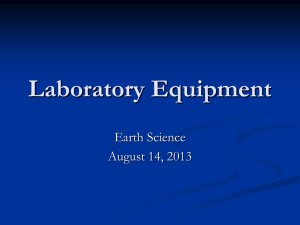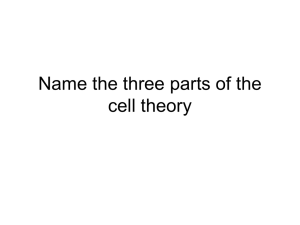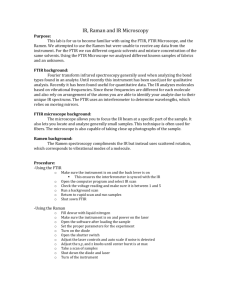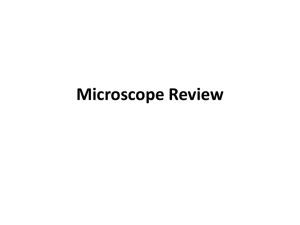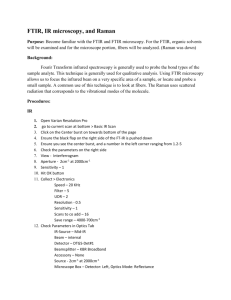IR & Ramen
advertisement
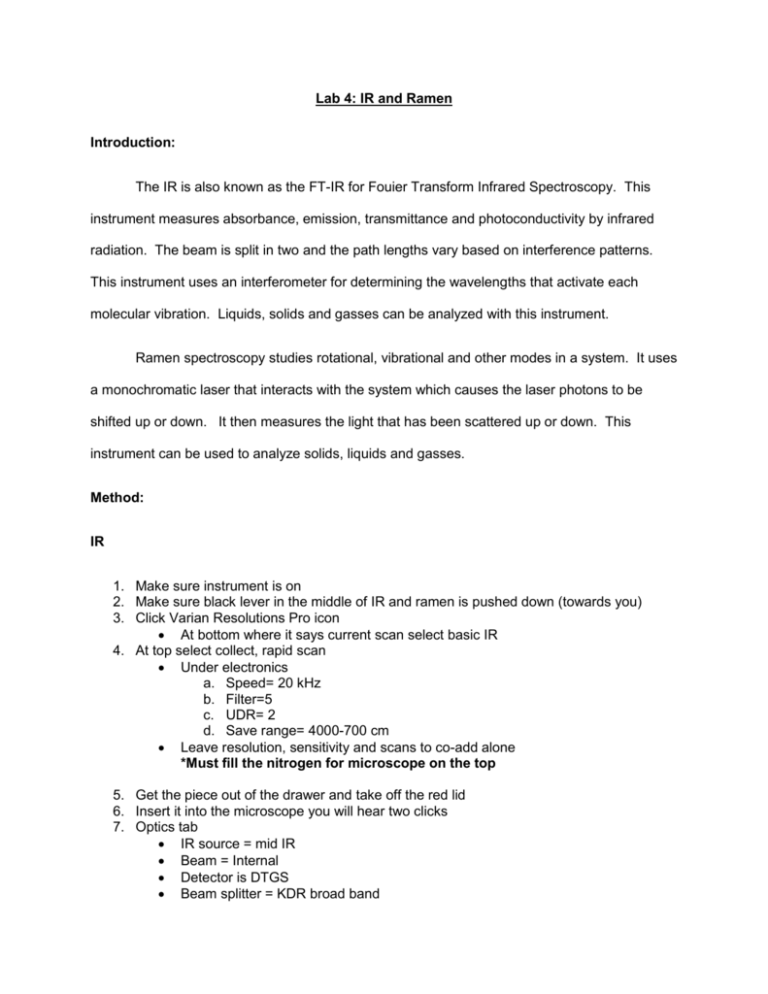
Lab 4: IR and Ramen Introduction: The IR is also known as the FT-IR for Fouier Transform Infrared Spectroscopy. This instrument measures absorbance, emission, transmittance and photoconductivity by infrared radiation. The beam is split in two and the path lengths vary based on interference patterns. This instrument uses an interferometer for determining the wavelengths that activate each molecular vibration. Liquids, solids and gasses can be analyzed with this instrument. Ramen spectroscopy studies rotational, vibrational and other modes in a system. It uses a monochromatic laser that interacts with the system which causes the laser photons to be shifted up or down. It then measures the light that has been scattered up or down. This instrument can be used to analyze solids, liquids and gasses. Method: IR 1. Make sure instrument is on 2. Make sure black lever in the middle of IR and ramen is pushed down (towards you) 3. Click Varian Resolutions Pro icon At bottom where it says current scan select basic IR 4. At top select collect, rapid scan Under electronics a. Speed= 20 kHz b. Filter=5 c. UDR= 2 d. Save range= 4000-700 cm Leave resolution, sensitivity and scans to co-add alone *Must fill the nitrogen for microscope on the top 5. Get the piece out of the drawer and take off the red lid 6. Insert it into the microscope you will hear two clicks 7. Optics tab IR source = mid IR Beam = Internal Detector is DTGS Beam splitter = KDR broad band Accessory = none ATR crystal = none Optical filter = none Source = 2 cm^-1 at 2000 cm^-1 Microscope Detector= left Optics mode = Reflectance 8. Click “set up” Want a number in the left hand corner to be between 1.5 and 5 Hit the four way arrow 9. Click “okay” 10. Don’t put anything on the sample plate and hit back ground Save and name it 11. Click collect, Rapid scan Background tab Make sure says status exists 12. Click compute, make sure right order a. Computer b. Ratio c. Truncate d. Stop e. Absorbance to % transmittance 13. Do all samples the same way *looked funny so we made our own IR Microscope 1. Remove the red cap from crystal 2. With nodes facing left side into microscope 2 clicks 3. Black lever between IR and ramen should be up (away from you) 4. Black leaver between Ramen and microscope should be up (laying down back) 5. Inside in the back right corner should be down or bypass open 6. Make sure ramen has bypass lit 7. Turn up the brightness on the microscope 8. Under current scan drop down at bottom pick microscope 9. Click collect, rapid scan 10. Under electronics Speed= 20 kHz Filter= 5 UDR= 2 Save Range = custom 4000-700 cm-1 Leave the others 11. Under optics IR source= Mid-IR Beam= right Detector= UMA600 MCT Beam Splitter= KBr Broadband Accessory= UMA -600 Optical Filter= None Source= Open Detector= Right Optics Model= Reflectance 12. Click setup 13. Burst appears (1.830) Click the 4 way arrow 14. Click okay 15. Place gold slide on microscope 16. Click collect, rapid scan, background 17. Collect, rapid scan, set up, processed 18. Adjust the course adjustment to put light pressure on the fabric sample 19. Hit the 4 way arrow 20. Scan 21. Samples: Samples IR 1. 2-1-1- toluene, 2-butanol, 2-propanol 2. 1-2-1- toluene, 2-butanol, 2-propanol 3. 1-1-2- toluene, 2-beutenol, 2-propanol 4. 2-2-1- toluene, 2-beutenol, 2-propanol 5. 1-2-2- toluene, 2-beutenal, 2-propenol IR Microscope 1. 80% cotton, 20% polyester 2. 50% cotton, 50%polyester 3. Polyester 4. Cotton 5. Acetate 6. PVC 7. Acrylic 8. Wool 9. Nylon 10. Unknown B 11. Unknown A Results The printed labeled spectrum for the IR is located on pages 75-80 of the lab notebook. The printed labeled spectrum for the Ramen is on pages 84-92 of the lab notebook. Conclusion The ramen was not working when we did our experiment. Therefore the two days consisted of the IR and the IR microscope only. The unknown sample for the IR looks most similar to the second sample we made (1-2-1- toluene, 2-buetnol, 2-propanol). For the microscope data, unknown C seemed to be different then all of the other standards we did. The peak between 2400-2200 percent transmittances was lower than those of the standards. There is also a similar peak to the rest of the standards between 1800-1600. The peak goes to about 40% transmittance which is also lower than any of the standards. We also ran unknown B which had the same peaks between 2400-2200 and 1800-1600. The peak between 2400-2200 is similar to acetute at around 88-90% transmittance. Again the peak between 1800-1600 did not match any of the standards.

